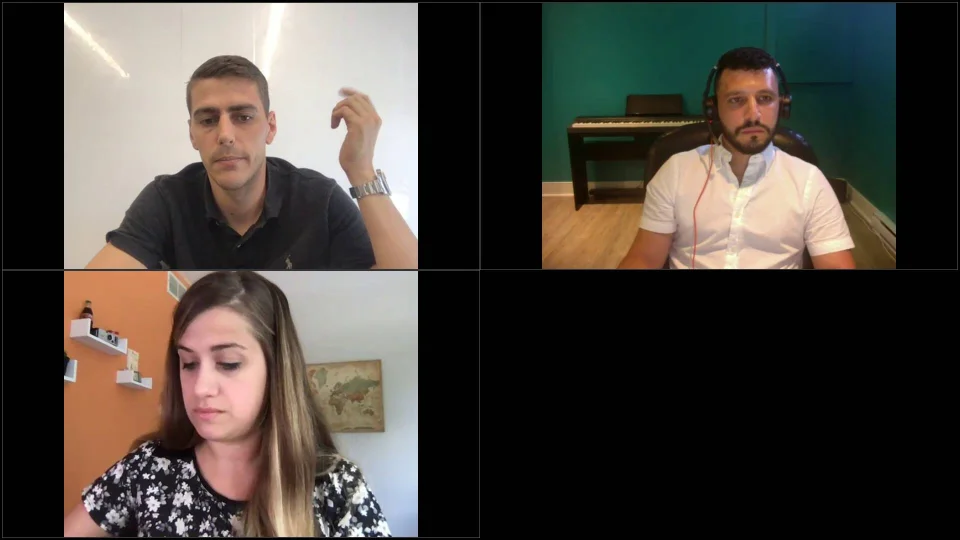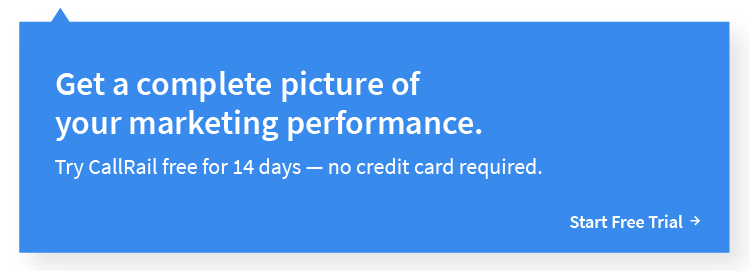VIDEO TRANSCRIPTION
Introduction
Meredith Stack: My name is Meredith Stack, and I'm the demand generation manager here at CallRail. I'm really excited to be joined today with healthcare marketing experts, and we are excited to hear from you and get your questions answered.
Allie Word: Hi, I'm Allie Word. I'm a senior marketing strategist at SmartBug, and I work very closely with some healthcare clients. Jonathan, would you like to just tell us a little bit about yourself and your business and how you use call tracking?
Jonathan Naccache: I am the co-founder and president at Webistry. We're a digital advertising agency, and we're very heavily focused on optimizing the customer journey online. From paid advertising to conversion rate optimization to improving internal operations and the customer experience, we touch every point on the journey.
Preston Powell: Hi, My name's Preston Powell. I'm a COO and co-founder at Window To Recovery. We're a digital marketing agency. Most of our clients are in the healthcare space, including plastic surgeons. As the director of operations, or COO, I manage a team of SEO professionals and PPC professionals, and I'm excited to talk today a little bit about patient care and how call tracking can help with that.
1. How can call tracking make an impact on marketing? What additional tracking information can I get through call tracking that I’m not already getting through Google Analytics?
Preston: With Google Analytics, you do get some form of conversion tracking. You can put tracking code on your website, you can track button clicks, you can track form submissions. However, CallRail, and other call tracking software, adds a tracking code that will dynamically change the phone number on your website. It'll also track form submissions.
But the benefit of the dynamic number insertion is if you had five users on your site, they'd all see a different phone number and it would follow them around. So, rather than just saying that, "Hey, a user came from search and converted," we can say, "Hey, this user came from search, landed on this page, clicked here, here, and here, left the page, came back two months later, engaged with this piece of content, and now they called."
You have a lot more insight on that user's journey to conversion, and it creates a lot of valuable insights, not only for patient experience, but also from a marketing standpoint.
If I know that people are tending to call when they are on this page, I can tailor my strategy to get more people onto that page through conversion rate optimization, changing the website around, moving links and buttons, but it's a lot more valuable insight to look at this user's timeline than it is to say, "Hey, some user came from search and they converted." Just a lot more valuable.
2. What are some of the ways that you've seen call tracking positively impact the patient experience?
Jonathan: Good question. It's not just the tracking, but how you use it. From my perspective, we're looking at patient acquisition, but that could equally be patient experience for existing patients. With a tool like CallRail, you can understand the source of your calls meaning where they are coming from. When you know that, you can direct calls to the right place.
For example, if you have calls coming from new patient campaigns, there's no need to make them go through your usual IVR system and call flow that gives them options for customer service, billing, et cetera. Make sure you direct that call immediately to the right person that's better equipped to handle it. We've seen through call tracking that those types of calls tend to drop out faster if they're waiting on the line or if they're on hold. This is new business, you've paid to get that business, and you need to make sure you reach out to them or pick up the phone as fast as possible.
Another example is through reporting. In CallRail, you can set certain filters, for example, the duration of a call. For one of our clients, we're driving about 300 unique callers per month and we're ecstatic. It was great. And then, I got on a call, and the client said, "We have no results this month." So, I dug through the reporting, and we realized that because we had scaled up so fast, a good percentage, probably around 55% of their calls were missed calls.
We're able to address that by implementing better processes through their phone systems. Maybe they were understaffed, maybe we're driving calls at certain hours in the day where they're not capable of picking up (ie. lunchtime). Those are little, quick examples of how you can increase the patient care experience
Preston: With call tracking, it's got a lot of features. With CallRail, for example, you can make different call flows, you can increase the amount of answered calls, but you can also record calls. You can create menus so that callers get to the right place. It's not really a great customer experience if every single time a patient calls, maybe they've been there 100 times and they're getting the sales guy every time. Those are a few things that can increase patient experience.
With the marketing insights that you get, you can generate more qualified leads. As well as with call recording, you can understand how your staff is handling phone calls and improve over time by just training them. How we can train the employee to handle it better and deliver a better patient experience that way.
3. Does the ability to take those transcripts and use them for training purposes?
Jonathan: Yeah, recordings are great because there's a lot of qualitative data or contextual information that you can gain from that. We've used that when we realized we're getting so many calls, but the results aren't there. We also pick up on certain patterns.
Transcripts are really useful because when you're having a very high volume of calls, especially in the health vertical, that happens a lot through new patients, existing patients, outgoing calls. That could be really useful.
We use CallRail’s Conversation Intelligence, which first step is we'll transcribe your calls so that it can then analyze it. You can tag calls as an appointment every time the word confirmed is spoken on that call. Transcripts can automate some of the process that could be very manual and laborious to just listen to every call, and it will automate the process of tagging certain calls based on verbal cues.
4. What if I have a campaign that is driving a lot of phone calls, but those phone calls are not necessarily turning into new appointments? What are some of the questions you would ask or some of the optimizations that you would recommend to make sure that you're targeting the right leads?
Jonathan: I have multiple answers for this one. I'll start with the most important one.
- As an agency, we look at call conversions and call attribution, which is knowing exactly where that call came from. Tracking could be simple or more complex. You have one call tracking number for each marketing channel (online or offline) and you know that that campaign drove these calls. For a more complex scenario with Google search ads, you may have multiple campaigns and within each campaign, a bank of keywords you're bidding on. Through CallRail's Google Ads integration, you which keywords are bringing the good quality calls and which ones are bringing the calls that do not convert. This becomes a process of not just optimizing for lead volume or call volume or even cost per call, but mostly optimizing for lead quality or call quality.
- Through conversation intelligence, you can see if there are patterns throughout your call. If you have 20% of your calls that are dissatisfied because there are certain verbal cues being spoken, we dig deeper and listen to those calls and see what's happening.
- Through reporting tools in CallRail, we can tell if a lot of calls are missed calls, if certain calls are not lasting very long, and some are lasting way too long. There's so many filters that you can add to your reporting to gain more insights.
Preston: Attribution is so important, and in healthcare, attribution is a little more complex than with other verticals because it's not always cut and dry and somebody could be coming in for a one time procedure. It's hard to understand what a patient's lifetime value is. But one of the biggest things that CallRail has helped us with that has really increased the quality of leads is keyword level tracking.
You can use your Google Ads tracking and track at the keyword level, so you can say that, "I got to click on this ad based upon this keyword that triggered it," and that will actually show up in CallRail if you set it up correctly.
I recently did this for a client in the behavioral healthcare space. They were getting a lot of clicks, and calls, from a certain keyword. And we look at a CPA, and we're like, "Oh, we drove down their CPA quite a bit," but how does that actually impact their revenue? With keyword level tracking and call recordings, we were able to determine that all of these calls coming from this particular keyword were really bad. They weren't converting to revenue for the client. So, we eliminate that keyword, which Google Ads would have told us, said, "Hey, this is the best performing keyword in your entire account." We saved about 50% of their spend. Our cost per lead almost doubled, but they were getting qualified admissions into a treatment center because of that. Sure, they're getting less calls, the calls for costing more money, but it was actually driving revenue.
A lot of times, leads or phone calls are a vanity metric. It doesn't really mean anything unless it's driving revenue for your business. CallRail has really helped us to be able to isolate wasted spend and eliminate it.
5. How do you use CallRail forms to automatically send new leads over to the right person quickly?
Jonathan: We know that a majority of leads in the health sector come through calls. We try to analyze why, and the main reason was that most forms are very demanding on the user. They request information beyond just a phone number or an email, a first name, last name, email, number, and some other information. We realized that people in certain industries don't like to give out that information. So, we try to see if we could come up with a different type of form that is more frictionless without hindering the ability to reach out to that person, where the odds of that person will respond.
We came up with a “request to call back form.” The reason we came up with that is because we know that when people fill out forms, now we're relying on someone on the business side to check their emails. Not only do they have to check their emails, but they have to find that particular email or that particular time, reply back, wait for a response, and there's that back and forth for scheduling a call. It's a lot of waste of time, and most people end up not getting back to you by then.
We learned that to increase your chances of reaching that lead, you need to be able to reach out to them at the moment that they fill out the form. By asking for the phone number and using CallRail's form tracking, CallRail calls it a call alert that will automatically dial the front desk or the sales person. It'll notify them that they have a form submission, and it'll offer them the chance to call that lead immediately. And all of that happens within 30 seconds. It's seamless, and it increases your response rate, your booking rate, and improves your customer experience.
6. Are there any integrations you're using between CallRail and other systems that have helped you?
Preston: Yeah, I use quite a few. The main ones are:
- Google Analytics: Analytics will report conversions from CallRail. It’s much better than tracking a button click because people sit on their computers and type the number in the phone, and that can't really be tracked through Google analytics on its own.
- Google Ads: Google Ads also reports conversions directly from CallRail.
- Google My Business: GMB is great for separating out where leads are coming from.
Integrations beyond that, you can email form submissions, you can integrate with different CRMs, you can use Zapier with all their integrations. But when a lead comes in, we can fill out a Google form that can just be a shared document for somebody that may not have a CRM or doesn't want to use one, but wants to look at a spreadsheet with all their lead data in it. There's a number of them in healthcare. It's a little bit different just because everything has to be HIPAA compliant.
7. If I work with an agency running my PPC campaigns, do I still need call tracking?
Preston: We're an agency that runs PPC campaigns for people and we insist that people use some sort of call tracking. We provide all of our clients with CallRail. If you're working with an agency and they're not tracking your calls, you might want to start looking somewhere else because if you can't track your calls, it's really, really hard to get better.
We’re able to identify a lot of wasted spend through using call tracking. If we weren't able to do that, we would blindly be relying upon the conversion data in Google Ads.
That doesn't really have any meaning behind it, and we'd be thinking that we're getting great results for these people that weren't driving revenue at all. So, yeah, if you work with an agency, they should be providing you some sort of call tracking or insisting that you have it.
8. if you were to summarize the greatest impact that you've seen from call tracking, what would you say that is?
Jonathan: I'll sum it up in two categories:
- Agency-side: Call tracking has given us the ability to optimize on multiple levels, not just for traffic, but for lead volume, for lower cost per leads, and most importantly for lead quality, so leads that convert, take appointments, show up to their appointments. So, as an agency, internally, we've been able to offer better results, better performance, more accountability, more transparency.
- Client-side: Call tracking has led to better results, but most of all, more accountability, for them to know where their budget should be allocated, what's bringing them results, how to help them make better decisions. For quality control, like Preston said, listening to calls allows you to pick up on certain things that you could improve.
Preston: I would split it up the same way:
- As an agency, attribution is huge. If I can't represent my client, the value that our services have brought them, then I'm not going to keep that client for very long. If we can't represent what our value is to a client, they should fire us. It's just a logical thing to do.
- For our clients or any clients at all, call tracking offers a benefit outside of marketing, which is customer service. It’s vital to those calls and improving your internal processes to better handle calls and better handle customer service inquiries and improve sales performance. Otherwise, you just have to blindly trust that the people that work for you that are answering phones are doing everything correctly, and, ultimately, they're human and they're not always going to.







